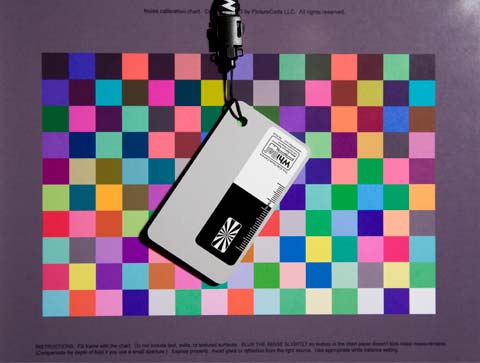I recently decided that a new tool would be nice and that I needed a fairly compact camera that performs well under low light conditions. Both the Canon G9 and the Panasonic DMC-FZ18 seemed interesting from their specs. [I also looked at FujiFilms offering because in the past they performed very well at high ISO. Unfortunately, a camera with the SuperCCD and image stabilization is currently missing from their model lineup.]
Trawling the net for hard information on sensor noise for these fairly new cameras proved to be a frustrating experience. There seems to be very little information available that allows a good comparison of various cameras. Yes, I know there are many snapshots available, but the conditions under which they are taken varies greatly.
The big review sites (I personally prefer dpreview.com) are somewhat better, but none had a review of both cameras online. In fact, dpreview had published a review on neither camera.
So I decided to create my own test setup to determine how the cameras that I have access to perform and to allow a comparison. Because I just got it, I started with the Canon G9.
Setup
In order to control lighting, I chose a cellar room that can be blacked out completely. I then set up a 500W halogen spotlight to provide the only illumination.
My test target is a noise profiling chart from PictureCode LLC, the makers of Noise Ninja and a WhiBal white balance reference card. Apart from having the advantage of being on hand, the profiling chart allows me to easily run Noise Ninja and the WhiBal card allows easy white balance adjustment of the captured images. I prefer to work smarter, not harder, when possible. 🙂

Test target used for measurements.
If you look closely, you will see a bit of glare in the upper right hand corner. This proved not to be a problem (i.e. no overexposure occured) but it is something to improve the next time around.
The camera was mounted on a tripod. I use a cable release when evailable to minimize vibrations. Absolutely no flash was used.
Procedure
I used manual focus and exposure control to ensure correct results. RAW capture was used to ensure that a minimum of in-camera processing would be performed.
I took a picture with every ISO setting available to the camera (adjusting the exposure, of course).
After downloading the images from the memory card to my computer, I converted the files to DNG format and opened them in Adobe Camera Raw 14.8.0 (with Photoshop CS3). In ACR I performed white balance adjustment and the default exposure adjustments (Blacks 5, Brightness +50, Contrast +25). Noise reduction and sharpening where both turned off.
After RAW conversion, I used Noise Ninja 2.2.0a and auto-profiled the image and used the default settings for noise reduction and sharpening. I then created a 100% crop and saved this with and without Noise Ninja processing (smart objects are great! 😉 ).
Results
You can find the images here.
Even at ISO 80, the lowest ISO supported by the sensor, the image is not noise free. This is quite different from a DSLR, but what do yu expect from such a small sensor?
Up to ISO 200 I find the image useable without noise removal, but if desired Noise Ninja does a very good job of cleaning the image up.
At ISO 400 noise becomes pronounced. Noise Ninja manages to keep things under control, but barely.
At ISO 800 noise even after Noise Ninja processing is too pronounced for my tastes.
ISO 1600 is … well, let’s just say it is there, but I will be unlikely to use it.
Noise Ninja seems to do much better cleaning up an image that has not been processed before. I think that Canon deserve some credit for resisting the temptation to “enhance” the RAW image like some other manufacturers (and Canon themselves with other models).
I have read some comments that the G9 provides “DSLR-like” quality. I find this quite a mouthful – and in no way substantiated by my findings. I will back up this assessment with some measurements from a DSLR in the near future.
That said, what Canon pull off with such a small sensor is simply amazing. The images are quite stunning up to and including ISO 400 – that is a lot more than many other cameras currently manage.
Tags: camera, Canon G9, measure, noise, Noise Ninja, sensor noise, test procedure, test target, WhiBal
Comments are now closed.


1 comment